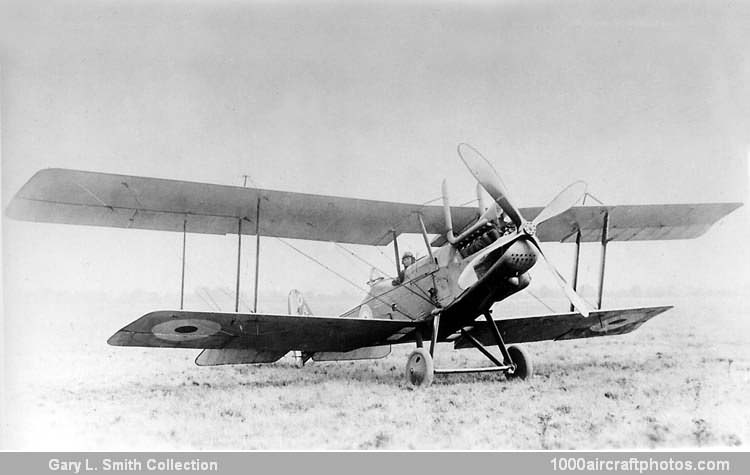Two prototypes (7996 and 7997) were completed, the first flying on June 17, 1916 and the second about three weeks later. They were powered by R.A.F. 4a engines, which remained the standard installation in production R.E.8s, and had B.E.2e-type wings with marked stagger and dihedral Production began in August 1916, the first few machines having, like the prototypes, a drum-fed Lewis gun mounted low down in the cockpit and firing between propeller blades fitted with bullet deflector plates. A ring-mounted Lewis was provided in the rear cockpit.
Standard front armament of the R.E.8 soon became a Vickers gun, mounted under the port side engine panels and synchronized at first with Challenger and later with Constantinesco gear. Deliveries began in November 1916, the first aircraft arriving in France later that month with RFC No. 56 Squadron. Due to the inexplicable reduction in fin area on production R.E.8s, the aircraft made a catastrophic start to its career when several were lost in spinning and other accidents or from fires that broke out when they crash-landed. As a result, the upper and lower fin areas were enlarged slightly on later aircraft.
The R.E.8 was the most widely used British two-seater on the Western Front, 4,099 being completed by seven British manufacturers. These included 22 supplied to Escadrille 6 of the Belgian Aviation Militaire that were later re-engined with 150 or 180 hp Hispano-Suizas. R.E.8s equipped sixteen RFC/RAF squadrons in France, and the type was in service throughout 1917-1918. Their duties included observation, reconnaissance, ground-support patrols, night bombing (with two 112 lb (51 kg) or equivalent smaller bombs) and ground attack (with four 65 lb (29.5 kg) bombs).
Despite the fact that they were outclassed by enemy fighters, they served the Allied cause well for a much longer period than should have been necessary, and fifteen RAF squadrons still had R.E.8s at the time of the Armistice. They were used by two British squadrons in Italy, two in Mesopotamia and four in Palestine; three Home Defence units also had some R.E.8s. A few remained in RAF service for a short time after the war.
Variants included the R.E.8a, with a 200 hp Hispano-Suiza and its Vickers gun on top of the front fuselage; it is thought that only one R.E.8a was built. The R.E.9 and R.T.I were both potential R.E.8 replacements, utilizing many components of the latter aircraft. Several R.E.8s were converted to R.E.9s with equal-span wings and variously modified control surfaces; Siddeley-Deasy built six R.T.Is with a variety of power plants, unequal-chord wings and a Lewis gun over the top plane.
To all who flew in those days the R.E.8 was known as the Harry Tate. Only two survive, F3556 hangs in London's Imperial War Museum, the other, reportedly ex-A4719, is in the Musée Royal de l'Armée et d'Histoire Militaire in Brussels."
Span: 42 ft 7 in (12.98 m)
Length: 27 ft 10.5in (8.50 m)
Height: 11 ft 4.5 in (3.49 m)
Wing area: 150.7 sq.ft (14 sq.m)
Loaded weight: 2,678 lb (1,215 kg)
Max speed: 102 mph (164 kmh) at 6,500 ft (1,981 m)
Service ceiling: 13,500 ft (4,115 m)
Endurance: 4 hr 15 min
